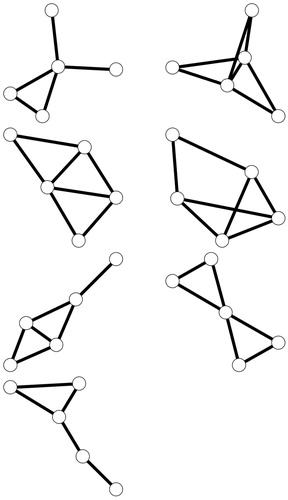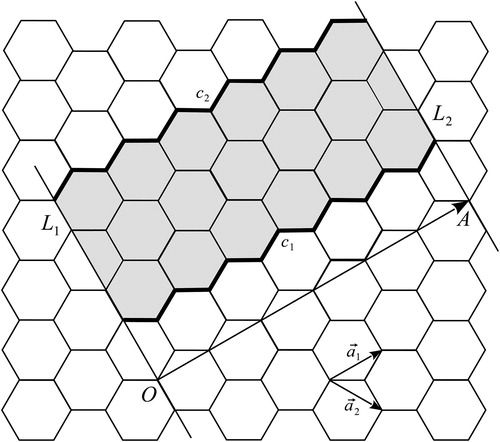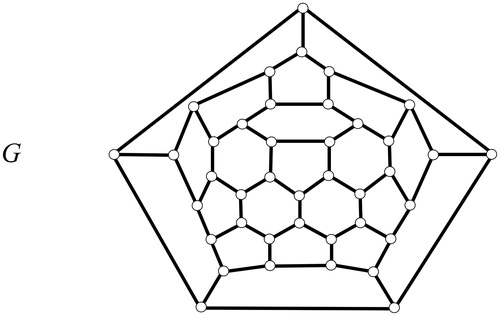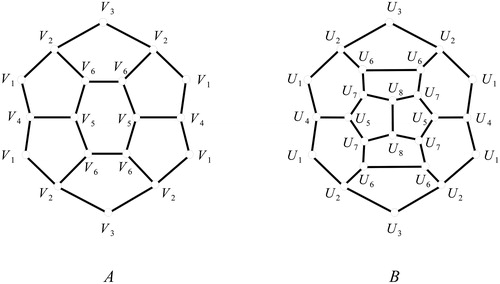 ?Mathematical formulae have been encoded as MathML and are displayed in this HTML version using MathJax in order to improve their display. Uncheck the box to turn MathJax off. This feature requires Javascript. Click on a formula to zoom.
?Mathematical formulae have been encoded as MathML and are displayed in this HTML version using MathJax in order to improve their display. Uncheck the box to turn MathJax off. This feature requires Javascript. Click on a formula to zoom.Abstract
The Graovac-Pisanski index, also called the modified Wiener index, was introduced in 1991 and represents an extension of the original Wiener index, because it considers beside the distances in a graph also its symmetries. Similarly as Wiener in 1947 showed the correlation of the Wiener indices of the alkane series with the boiling points, in 2018 the connection between the Graovac-Pisanski index and the melting points of some hydrocarbon molecules was established. In this paper, we prove that the Graovac-Pisanski index of any connected bipartite graph as well as of any connected graph on an even number of vertices is an integer number. These results are applied to some important families of hydrocarbon molecules. By using a computer programme, the graphs with a non-integer Graovac-Pisanski index on at most nine vertices are counted. Finally, an infinite class of unicyclic graphs with a non-integer Graovac-Pisanski index is described.
1. Introduction
In[Citation1] we can find the following definition: “The molecular descriptor is the final result of a logic and mathematical procedure which transforms chemical information encoded within a symbolic representation of a molecule into a useful number or the result of some standardized experiment.”
Since the seminal research by Wiener from 1947[Citation2] many molecular descriptors, i.e., graph invariants, were introduced. Different variations of the Wiener index have been known since then, one of them being the Graovac-Pisanski index,[Citation3] also called the modified Wiener index. The advantage of this index in comparison to other distance-based indices is in the encountering of the symmetries of a graph, since the symmetries of a molecule have an influence on its properties.[Citation4]
On one side, the mathematical properties of the Graovac-Pisanski index were investigated. For example, the index was intensely studied for nanostructures,[Citation5–10] some general results on the Graovac-Pisanski index were obtained,[Citation11,Citation12] the closed formulae for carbon nanotubes were calculated,[Citation13,Citation14] extremal trees were considered,[Citation15] and the symmetries of molecules were studied.[Citation16,Citation17] On the other side, the chemical usefulness of the Graovac-Pisanski index was shown in,[Citation18] where the connection with the topological efficiency was considered and later in,[Citation19] where the correlation with the melting points of some families of hydrocarbon molecules was established. This was done with the use of the QSPR analysis and for all the considered molecular graphs from[Citation19] the Graovac-Pisanski index is an integer number. Naturally, the question whether the Graovac-Pisanski index is an integer number for all connected graphs arises by this observation.
We proceed as follows. In the next section, some basic notation is introduced and important definitions are included. In Section 3, we prove that the Graovac-Pisanski index of any connected bipartite graph is an integer number. Moreover, we show that the same conclusion holds also for any connected graph with an even number of vertices. In particular, this means that for various molecular graphs the Graovac-Pisanski index is an integer, what is explained in Section 4. In the same section, the closed formula for the Graovac-Pisanski index of an infinite family of nanotubical fullerenes is deduced. Finally, in Section 5 we use a computer programme to obtain the number of connected graphs on at most nine vertices for which the Graovac-Pisanski index is not an integer. An infinite family of graphs with a non-integer Graovac-Pisanski index is also included.
2. Preliminaries
All the graphs considered in this paper are simple, finite and connected. The distance between vertices u and v of a graph G is the length of a shortest path between vertices u and v in G. A bipartite graph is a graph whose vertices can be divided into two disjoint sets U and V such that every edge connects a vertex in U to one in V. Vertex subsets U and V will be called the bipartite sets of the graph.
The Wiener index of a connected graph G is defined as follows:
Also, for any we define
An isomorphism of graphs G and H is a bijection such that for any two vertices u and v from G it holds that u and v are adjacent in G if and only if f(u) and f(v) are adjacent in H. If
is an isomorphism then the function f is called an automorphism of the graph G. It is easy to check that the composition of two automorphisms is another automorphism. Moreover, the set of all automorphisms of a given graph G, under the composition operation, forms the automorphism group of G, denoted by
Let G be a connected graph. The Graovac-Pisanski index of G is defined as
Let us mention, that for the Graovac-Pisanski index, also known as the modified Wiener index, the notation is used, but to clear the confusion in the area of variations of the Wiener indices, we use the name Graovac-Pisanski index, as suggested in[Citation12] and denote it with the
Finally, we include some basic definitions from group theory. If G is a group and X is a set, then a group action of G on X is a function
that satisfies the following:
for any
(here, e is the neutral element of G) and
for all
and
The orbit of an element x in X is the set of elements in X to which x can be moved by the elements of G, i.e., the set
If G is a graph and
the automorphism group, then
defined by
for any
is called the natural action of the group
on V(G).
It was shown by Graovac and Pisanski[Citation3] that if are the orbits under the natural action of the group
on V(G), then
(1)
(1)
3. Main results
In this section we prove the main result of the paper, i.e., the Graovac-Pisanski index of any connected bipartite graph is always an integer number.
First, we will rewrite the Graovac-Pisanski index in another form. For this purpose, we need some additional definitions. Let G be a graph and let The distance of u in G,
is the sum of distances from u to all the other vertices of G. That is,
Moreover, if
and
then
Using the distance, one can rewrite the Wiener index for
as follows
(2)
(2)
Proposition 3.1.
Let G be a connected graph and let be the representatives of orbits
under the natural action of the group
on V(G). Then
Proof
If two vertices u, v are in the same orbit Vi, then it obviously holds
Since all the vertices in the same orbit have the very same sum of distances, inserting (2) into (1) we get
and the required result follows. □
By (3) we get the following observations.
Corollary 3.2.
If G is a connected graph with an even number of vertices, then is an integer number.
Corollary 3.3.
The Graovac-Pisanski index of any connected graph is either an integer or half of an integer number.
However, if G is bipartite, we can say more. The following result is the main result of this paper.
Theorem 3.4.
If G is a connected bipartite graph, then is an integer number.
Proof.
Let G be a bipartite graph and let U, V be the bipartition of V(G). That is, no edge connects two vertices of U and no edge connects two vertices of V. We consider two cases:
There is
such that
for some
and
In this case, we will show that ψ reverses the bipartite sets, i.e. for any
and
for any
To prove this, suppose that
but
also belongs to U. Since
the distance
is an even number. Therefore, since ψ is an automorphism,
must be even, too. Since
we obtain that
is even. But
and
and therefore, this is a contradiction. In a similar way one can show
for any
We have proved that ψ reverses the bipartite sets. Moreover, the restriction of ψ on U,
is a bijection from U to V. Consequently,
and
is even. By Corollary 3.2, the Graovac-Pisanski index of G is an integer number.
ii. There is no automorphism that reverses the bipartite sets.
In this case, if u and v are two vertices from the same orbit, these two vertices are also in the same bipartite set. Therefore, the distance between them must be even. Consequently, if are the representatives of orbits
under the natural action of the group
on V(G), all the distances
are even in (3), and so the Graovac-Pisanski index is again an integer number.
Since the Graovac-Pisanski index is an integer number in both cases, the proof is complete. □
4. Applications to molecular graphs
In this section we apply our main results to some well-known molecular graphs.
4.1. Paraffins, benzenoid hydrocarbons, phenylenes and carbon nanotubes
Paraffins (alkanes) are mathematically modeled by chemical trees, i.e., trees in which every vertex has degree at most four.
Let be the hexagonal (graphite) lattice and let Z be a cricuit on it. Then a benzenoid system is induced by the vertices and edges of
lying on Z and in its interior. In chemistry a benzenoid system is a mathematical model for a benzenoid hydrocarbon. Let G be a benzenoid system. A vertex shared by three hexagons of G is called an internal vertex of G. A benzenoid system is said to be catacondensed if it does not possess internal vertices. Otherwise it is called pericondensed. Two distinct hexagons with a common edge are called adjacent. Let G be a catacondensed benzenoid system. If we add squares between all pairs of adjacent hexagons of G, the obtained graph
is called a phenylene, see .
Next we formally define open-ended carbon nanotubes, also called tubulenes. Choose any lattice point in the hexagonal lattice as the origin O. Let and
be the two basic lattice vectors. Choose a vector
such that n and m are two integers and
Draw two straight lines L1 and L2 passing through O and A perpendicular to
respectively. By rolling up the hexagonal strip between L1 and L2 and gluing L1 and L2 such that A and O superimpose, we can obtain a hexagonal tessellation
of the cylinder. L1 and L2 indicate the direction of the axis of the cylinder. Using the terminology of graph theory, a tubulene G is defined to be the finite graph induced by all the hexagons of
that lie between c1 and c2, where c1 and c2 are two vertex-disjoint cycles of
encircling the axis of the cylinder.
For any tubulene G, if its chiral vector is G will be called an (n, m)-type tubulene, see [13. If G is a (n, m)-type tubulene where n = 0 or m = 0, we call it a zig-zag tubulene.
Proposition 4.1.
Let G be a paraffin, a benzenoid system, a phenylene or a tubulene. The Graovac-Pisanski index of G is an integer number.
Proof.
Obviously every paraffin is a bipartite graph and the same holds for benzenoid systems and phenylenes. It was shown in[Citation20] that tubulenes are bipartite graphs as well. Therefore, by Theorem 3.4 the Graovac-Pisanski index of G is an integer number. □
4.2. Fullerenes
A fullerene G is a 3-connected 3-regular plane graph such that every face is bounded by either a pentagon or a hexagon, see (obviously, fullerenes are not bipartite graphs). By Euler’s formula, it follows that the number of pentagonal faces of a fullerene is exactly 12. For more information on fullerenes see.[Citation21]
The following result about the Graovac-Pisanski index of fullerenes can now be stated.
Proposition 4.2.
Let G be a fullerene. The Graovac-Pisanski index of G is an integer number.
Proof.
Since all vertices in a fullerene have odd degrees, the graph must have even number of vertices. (It is well known that a fullerene with n vertices exists for any even and for n = 20, for the details see Theorem 2.2 in.[Citation21]) Hence, by Corollary 3.2 it follows that the Graovac-Pisanski index of G is an integer number.□
To conclude the section, we compute the Graovac-Pisanski index of an infinite family of nanotubical fullerenes denoted by Fn, In particular, Fn is obtained by the (6, 0)-type tubulene with n layers of hexagons (zig-zag tubulene such that every layer contains 6 hexagons), closed with two caps shown in .Citation22
We will use Proposition 3.1 to calculate the Graovac-Pisanski index of Fn. The orbits and corresponding representatives in the cap A are denoted by Vi and vi, The orbits and corresponding representatives of the cap B are denoted by Ui and ui,
First, we compute the distances of vertices vi, in the corresponding orbits:
The sum of all these distances is 43.
Moreover, we calculate the distances of vertices ui, in the corresponding orbits:
The sum of all these distances is 58. The orbits and the distances of the layers in the tubical part are analogous to the orbits Ui and distances
Obviously, it holds Therefore, by Proposition 3.1 we conclude
We observe that the Graovac-Pisanski index of fullerene Fn is an integer number for any Also, the Graovac-Pisanski index of two other families of nanotubical fullerenes was computed in[Citation18] and the result is again an integer number, what coincides with Proposition 4.2.
5. Graphs for which the Graovac-Pisanski index is not an integer
By Theorem 3.4, Corollary 3.2, and Proposition 4.2, many chemical graphs have integer Graovac-Pisanski index (for example the fullerene graphs, trees, hexagonal structures, etc.). Of course, there are also connected graphs whose Graovac-Pisanski index is not an integer. The smallest such graph contains 5 vertices.
In we present the number of connected graphs on n vertices, whose Graovac-Pisanski index is not an integer number. The results were obtained by using a computer programme.
Table 1. Number of connected graphs on 3, 5, 7, and 9 vertices, divided in those with an integer and those with a non-integer Graovac-Pisanski index.
In we can see all the connected graphs on 5 vertices whose Graovac-Pisanski index is not an integer number.
Figure 5. All connected graphs on 5 vertices for which the Graovac-Pisanski index is not an integer.

The following theorem presents an infinite class of unicyclic graphs for which the Graovac-Pisanski index is not an integer number.
Theorem 5.1.
Let G be a graph consisting of a cycle of odd length ℓ, where , to which we attach a path of even length t, where t is a positive integer. Then G has
vertices and
is not an integer number.
Proof.
In G there are orbits with two vertices and t + 1 orbits with one vertex. Let z be the vertex of degree 3 in G. Then the orbits with two vertices contain pairs of vertices at the same distance from z. Hence, the distances between the pairs of vertices from the same orbit are
and
It is easy to observe that the number is odd and consequently, the Graovac-Pisanski index is not an integer if and only if the number representing the binomial coefficient,
is odd. □
An example of a graph satisfying assumptions of Theorem 5.1 is presented as the last graph in .
Finally, we also remark that if G is a dual of a fullerene, then can be an integer number or not an integer number, what is apparent from the results in.[Citation18]
Additional information
Funding
References
- Todeschini, R.; Consonni, V. Handbook on Molecular Descriptors; Wiley-VCH: Weinheim, 2000.
- Wiener, H. Structural Determination of Paraffin Boiling Points. J. Am. Chem. Soc. 1947, 69, 17–20. DOI: 10.1021/ja01193a005.
- Graovac, A.; Pisanski, T. On the Wiener Index of a Graph. J. Math. Chem. 1991, 8, 53–62. DOI: 10.1007/BF01166923.
- Pinal, R. Effect of Molecular Symmetry on Melting Temperature and Solubility. Org. Biomol. Chem. 2004, 2, 2692–2699. DOI: 10.1039/B407105K.
- Ashrafi, A.R.; Diudea, M.V. (Eds.) Distance, Symmetry, and Topology in Carbon Nanomaterials; Springer International Publishing: Switzerland, 2016.
- Ashrafi, A. R.; Koorepazan-Moftakhar, F.; Diudea, M. V. Topological Symmetry of Nanostructures. Fuller. Nanotub. Car. N. 2015, 23, 989–1000. DOI: 10.1080/1536383X.2015.1057818.
- Hakimi-Nezhaad, M.; Ghorbani, M. On the Graovac-Pisanski Index. Kragujevac J. Sci. 2017, 39, 91–98. DOI: 10.5937/KgJSci1739091H.
- Koorepazan-Moftakhar, F.; Ashrafi, A. R. Combination of Distance and Symmetry in Some Molecular Graphs. Appl. Math. Comput. 2016, 281, 223–232. DOI: 10.1016/j.amc.2016.01.065.
- Koorepazan-Moftakhar, F.; Ashrafi, A. R. Distance under Symmetry. MATCH Commun. Math. Comput. Chem. 2015, 74, 259–272.
- Shabani, H.; Ashrafi, A. R. Symmetry–Moderated Wiener Index. MATCH Commun. Math. Comput. Chem. 2016, 76, 3–18.
- Ashrafi, A. R.; Shabani, H. The Modified Wiener Index of Some Graph Operations. ARS Math. Contemp. 2016, 11, 277–284. DOI: 10.26493/1855-3974.801.968.
- Ghorbani, M.; Klavžar, S. Modified Wiener Index via Canonical Metric Representation, and Some Fullerene Patches. ARS Math. Contemp. 2016, 11, 247–254. DOI: 10.26493/1855-3974.918.0b2.
- Tratnik, T. The Graovac-Pisanski Index of Zig-Zag Tubulenes and the Generalized Cut Method. J. Math. Chem. 2017, 55, 1622–1637. DOI: 10.1007/s10910-017-0749-5.
- Tratnik, N.; Pleteršek, P. Ž. The Graovac-Pisanski Index of Armchair Tubulenes. J. Math. Chem. 2018, 56, 1103–1116. DOI: 10.1007/s10910-017-0846-5.
- Knor, M.; Škrekovski, R.; Tepeh, A. Trees with the Maximal Value of Graovac-Pisanski Index. Appl. Math. Comput. 2019, 358, 87–292.
- Koorepazan-Moftakhar, F.; Ashrafi, A. R. Note on Symmetry of Molecules. MATCH Commun. Math. Comput. Chem. 2017, 78, 273–279.
- Koorepazan-Moftakhar, F.; Ashrafi, A. R.; Mehranian, Z. Symmetry and PI Polynomials of C50+10n Fullerenes. MATCH Commun. Math. Comput. Chem. 2014, 71, 425–436.
- Ashrafi, A. R.; Koorepazan-Moftakhar, F.; Diudea, M. V.; Ori, O. Graovac-Pisanski Index of Fullerenes and Fullerene-like Molecules. Fuller. Nanotub. Car. N. 2016, 24, 779–785. DOI: 10.1080/1536383X.2016.1242483.
- Črepnjak, M.; Tratnik, N.; Pleteršek, P. Ž. Predicting Melting Points of Hydrocarbons by the Graovac-Pisanski Index. Fuller. Nanotub. Car. N. 2018, 26, 239–245. DOI: 10.1080/1536383X.2017.1386657.
- Tratnik, N.; Pleteršek, P. Ž. Some Properties of Carbon Nanotubes and Their Resonance Graphs. MATCH Commun. Math. Comput. Chem. 2015, 74, 185–196.
- Andova, V.; Kardoš, F.; Škrekovski, R. Mathematical Aspects of Fullerenes. ARS Math. Contemp. 2016, 11, 353–379. DOI: 10.26493/1855-3974.834.b02.
- Andova, V.; Blenkuš, D.; Došlić, T.; Kardoš, F.; Škrekovski, R. On Diameter of Nanotubical Fullerene Graphs. MATCH Commun. Math. Comput. Chem. 2015, 73, 529–542.




